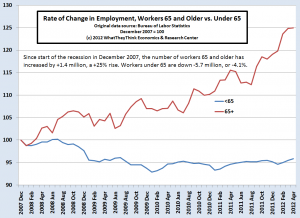Last week's employment report certainly put a damper on things. The improvement in the headline unemployment rate, down to 8.1%, was good news. Sure the cake looks great on the outside, but when you cut inside, other problems become visible. The stock markets, concerned about Europe, also took this report as a slowing economy, and has been delivering indigestion to investors for the last week.
We still believe that the headline unemployment rate will be 7.5% by the end of the year, mainly for the wrong reasons. Friday's report previews how it will happen.
The household survey of Friday's report showed continued deterioration in the labor participation rate as it fell from 63.8% to 63.6%. It has not been at this level since December 1981. The rate peaked in April 2000 at 67.3%. It was 66% or above from October 1988 to July 2007. The participation rate fell because the size of the labor force fell by -342,000 and the number of employed workers fell by -169,000.
One curious aspect of the employment trends is the assumption that many older workers are leaving the workforce, and the retirement of the baby boomers is decreasing the workforce. Because they can't find work, they're drawing Social Security benefits early. The baby boomer population is huge, so it can have conflicting trends operating at the same time, and both of those trends can be of significant numbers on their own. The net number, however, is a surprise.
The number of workers 65 and older is now 7.231 million. In December 2007, it was 5.787 million. The monthly changes have declined only in 15 of 48 months, and is 25% higher than it was in December 2007. Since start of the recession in December 2007, the number of workers 65 and older has increased by +1.4 million. Workers under 65 are down -5.7mil, or -4.1%. (click to enlarge chart)

Printing industry employment held steady in April, compared to March (+200). This implies that April shipments will be about the same as March. Industry employment is still -3.7% lower than last year (-17,700 workers). Agency and design employment continues to head in the other direction, up +3.4%, and nearly the identical number of workers up (+16,500) that printing industry workers is down. (Click chart to enlarge)

 Printing industry employment held steady in April, compared to March (+200). This implies that April shipments will be about the same as March. Industry employment is still -3.7% lower than last year (-17,700 workers). Agency and design employment continues to head in the other direction, up +3.4%, and nearly the identical number of workers up (+16,500) that printing industry workers is down. (Click chart to enlarge)
Printing industry employment held steady in April, compared to March (+200). This implies that April shipments will be about the same as March. Industry employment is still -3.7% lower than last year (-17,700 workers). Agency and design employment continues to head in the other direction, up +3.4%, and nearly the identical number of workers up (+16,500) that printing industry workers is down. (Click chart to enlarge)















